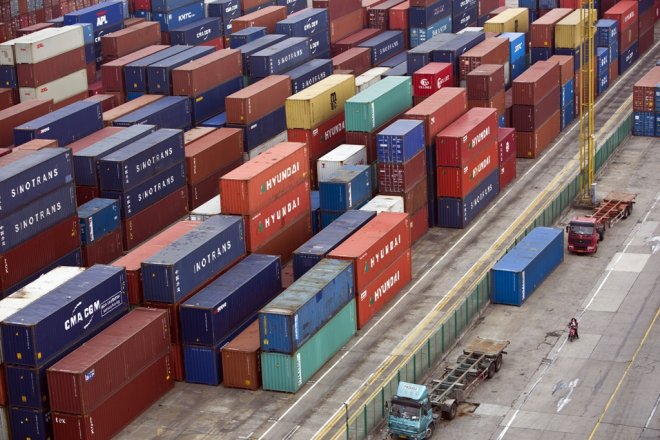
Volatility in trade figures and pandemic
Pakistan needs to comprehensively review its trade facilities, processes to reduce volatility
KARACHI:
The volatility in recent economic indicators is unprecedented.
Covid-19, above-normal monsoon rains and the accompanying devastation in Karachi in August 2020, the high risk of floods and the locust swarms attacking agricultural fields have combined with the pre-Covid-19 balance of payments crisis to pose one of the biggest challenges to economic policymakers.
Exports in August 2020 were 20.84% lower than that reported in July 2020 and 14.75% lower year-on-year. On the other hand, the month-on-month increase in exports in July 2020 of 25.14% and year-on-year increase of 6.10% suggested a sharp recovery from the Covid-19 plunge.
Imports too decreased year-on-year by 10.65% in August 2020 and month-on-month by 9.53%. With both exports and imports falling, the aggregate recovery in trade in the past few months has rather been subdued.
Exports in August 2020 declined across all major categories, both month-on-month and year-on-year.
Exports of food products decreased 19.58% year-on-year and almost 30% month-on-month. Exports of rice, fish and fish preparations, fruits and vegetables decreased more than 30% month-on-month.
Exports of textile products declined 15.35% year-on-year and 20.83% month-on-month. The decline in exports of knitwear, bedwear, readymade garments and towels exceeded 20% month-on-month.
The decline in exports was consistent across products. This suggests that there was an overall slowdown in export-related activities in the economy, rather than specific sector-level issues.
On the other hand, even though imports showed an overall decline in August 2020 compared to both July 2020 and August 2019, there was an increase in imports of textile group both month-on-month and year-on-year.
This was driven by a sharp increase of more than 10 times year-on-year and 30% month-on-month in imports of raw cotton. Imports of synthetic fibre increased more than 20% month-on-month. This suggests that textile producers are expecting a revival in their production and ultimately their export sales.
However, the challenges to agricultural production are apparent as demand for foreign inputs is increasing.
It is important to note that as per data extracted from Trademap.org, imports of cotton, neither carded nor combed, decreased more than 32% in 2019. Similarly, imports of man-made filaments and man-made staple fibres declined as well.
However, exports of articles of clothing increased 6.7% in 2019 over 2018. This suggests that either local inputs were more intensively used in export production or there was an improvement in the efficiency at which inputs were mixed to produce the exportable output.
Current account
As the pendulum swings, a look at the summary of balance of payments provided by the State Bank of Pakistan (SBP) suggests that remittances are at an all-time high.
Remittances received in the first two months (Jul-Aug) of FY21 were $1.1 billion more than the amount received in the same period in FY20. The current account surplus was reported at $805 million for the first two months of FY21.
This is notable given that the current account was in deficit at $1.21 billion in the first two months of FY20.
A $2 billion positive shift in the current account for an economy recovering from the balance of payments crisis, even if it comes with major contribution from worker remittances, is a significant accomplishment.
As foreign exchange reserves increase and the current account balance stabilises, Pakistan can reduce the risks associated with a perpetual debt trap and mitigate chances of a balance of payments crisis it has routinely experienced.
The recently released data for the SBP-IBA Business Confidence Index indicates a strong economic recovery since the short collapse due to the Covid-19 pandemic.
The overall Business Confidence Index has returned to the positive zone, for the first time since December 2019. It reported a sharp upswing from the level in June 2020. The recovery has been consistent across all sectors.
It is pertinent to mention that the expected Business Confidence Diffusion Index crossed 60 across all sectors, suggesting positive trends for the next six months. The Purchasing Managers Index and the Current Employment Index showed a relatively subtle uptick. This is a clear indication of the restoration of confidence of the business sector.
Trade facilitation
Although there are certain indicators that are revealing a promising picture regarding economic recovery and others display more volatile conditions, it is imperative that Pakistan improve its trade-related infrastructure to not only reduce volatility but also boost its export potential.
The UN Global Survey on Digital and Sustainable Trade Facilitation gives Pakistan a trade facilitation score of 40.86% in 2015, 50.54% in 2017 and 59.14% in 2019. Regionally, Pakistan ranks below India, Iran and Turkey.
In 2015, Pakistan also ranked below Sri Lanka and the Maldives. Although the score has significantly improved in the last four years, there are certain deficiencies that need to be addressed.
For instance, Pakistan performs poorly on cross-border paperless trade implementation. This is likely to be limited without the presence of an electronic single window system and an electronic application system to comply with foreign trade regulations.
Pakistan needs to further boost its own regulatory authorities so that they can instantaneously provide necessary certifications for trade. Pakistan lacks a comprehensive trade portal that not only lists the exact procedures and documentations required for trade but also provides detailed information to exporters and importers about costs, time and the high-ranking officials and their offices relevant to each process.
Traders in several less developed countries have access to such information, which not only facilitates trade but ensures the building of trading relationships. Such a portal will provide a significant boost to exports from Pakistan.
Furthermore, a trade portal containing business process analysis and detailing each trading activity can significantly reduce the cost and time involved in participating in international trade.
In essence, Pakistan needs to comprehensively review its trade facilities and processes in order to boost trade and reduce the volatility in numbers.
The writer is the Assistant Professor of Economics & Research Fellow at CBER, IBA
Published in The Express Tribune, Septe0mber 28th, 2020.
Like Business on Facebook, follow @TribuneBiz on Twitter to stay informed and join in the conversation.















COMMENTS
Comments are moderated and generally will be posted if they are on-topic and not abusive.
For more information, please see our Comments FAQ